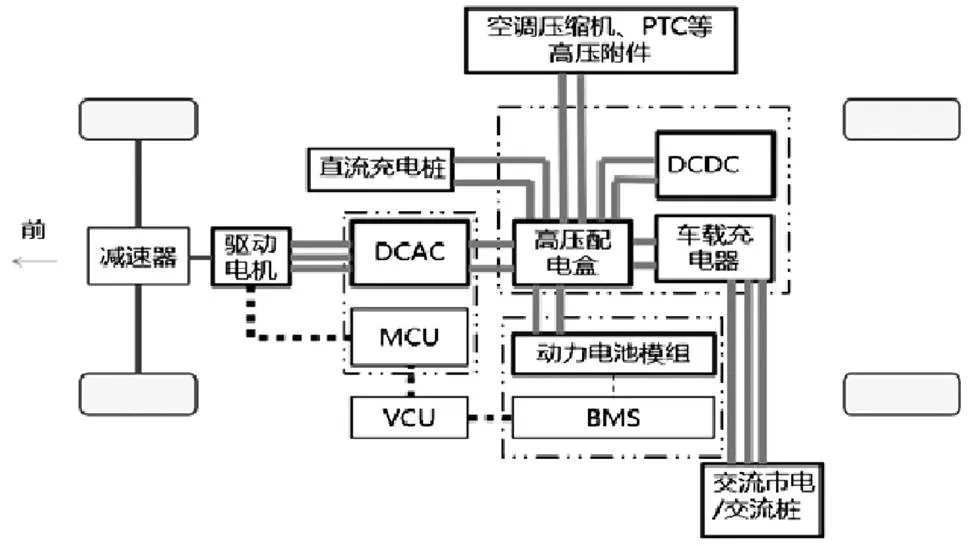基于NEDC循環(huán)工況純電動車能量回收的應用研究
李日業(yè)
基于NEDC循環(huán)工況純電動車能量回收的應用研究
李日業(yè)
(福建新龍馬汽車股份有限公司,福建 龍巖 364101)
隨著純電動車的普及推廣,大眾對能量回收的概念有了更為清晰的了解。文章以某品牌純電動MPV在NEDC循環(huán)工況下為例,闡述了理論可回收能量和實際可回收能量的差異及影響因素,并通過調(diào)整整車能量回收控制策略進行車輛實測,為純電動汽車能量回收以及降能耗的控制策略提供參考。通過統(tǒng)計分析NEDC循環(huán)工況加速、勻速及減速階段的典型工況數(shù)據(jù)特征,將NEDC循環(huán)工況分解成36個運轉(zhuǎn)次序,同時根據(jù)汽車的力學公式及電機電控效率,計算單個循環(huán)工況理論上減速工況所產(chǎn)生的可回收電量占工況所消耗總能量的18.6%。通過調(diào)整整車能量回收控制策略,調(diào)整車輛能量回收時產(chǎn)生的減速度接近NEDC循環(huán)工況減速度,同時將該車置于環(huán)境艙內(nèi)轉(zhuǎn)鼓按NEDC循環(huán)工況分別測試該車在無能量回收及有能量回收的續(xù)駛里程及能量消耗量,測試結(jié)果表明,車輛續(xù)駛里程由281.3 km增加至329.3 km,能量回收帶來48 km的里程數(shù)增加,無能量回收車輛耗電量為44.4 kWh,百公里耗電量約為15.69 kWh,對應48 km電量為7.53 kWh,占無能量回收時總消耗電量的16.96%,已接近理論值。在電機電控等系統(tǒng)效率不變、車輛內(nèi)阻不變的情況下,定義能量回收策略時通過調(diào)整車輛能量回收時產(chǎn)生的減速度接近NEDC循環(huán)工況減速度,可提升能量回收率。
NEDC;能量回收;純電動車;MPV
引言
純電動汽車與傳統(tǒng)能源汽車相比最重要的特性之一是其具有制動能量回收能力[1],可以把原本在減速階段白白被剎車消耗掉(轉(zhuǎn)化為熱量)的車輛動能,再次通過電動機(此時作為發(fā)電機使用)轉(zhuǎn)化為電能給電池充電,這是純電動汽車節(jié)約能源的優(yōu)勢所在。因此降低能量損失盡可能提高能量回收利用率,是提高電動車的續(xù)航里程的重要舉措,也是擺在研發(fā)純電動汽車的課題之一。下面就基于NEDC循環(huán)工況結(jié)合某公司純電動MPV車制動能量回收的應用進行研究。
1 NEDC循環(huán)工況

圖1 NEDC循環(huán)工況示意圖
眾所周知,NEDC循環(huán)工況誕生于20世紀末的歐洲[2],中國在本世紀初沿用至今,主要由四個市區(qū)工況和一個市郊工況組成,體現(xiàn)車輛使用中的三個典型工況為加速、勻速及減速階段如圖1所示。
統(tǒng)計NEDC綜合工況發(fā)現(xiàn)其數(shù)據(jù)特征如表1所示:
表1 NEDC循環(huán)工況數(shù)據(jù)特征
特征參數(shù)數(shù)值 平均速度/(km/h)運行速度/(km/h)平均加速度/(m/s2)33.643.50.53 平均減速度/(m/s2)加速比例/%減速比例/%勻速比例/%怠速比例/%?0.7523.216.637.522.6
2 NEDC循環(huán)工況典型工況下的可回收能量
基于NEDC循環(huán)工況,純電動車的一大優(yōu)勢是在減速階段可將機械制動的能量通過電機轉(zhuǎn)換為電能,假設減速階段除了克服內(nèi)阻和風阻的功率損失,其余能量均通過電制動回收(循環(huán)工況最大減速度為1.39 m/s2,機械制動不介入工作),則該值為理論最大可回收能量。該車型EV結(jié)構(gòu)原理圖如圖2所示。
從以上原理圖可以看出:電動車與傳統(tǒng)車的區(qū)別在于其減速時,動能多了一個轉(zhuǎn)變方向,可轉(zhuǎn)換為電池電能再次回收利用。這也就是我們所熟知的能量回收。能量回收強度可通過減速度體現(xiàn)。當能量回收減速度達不到日常駕駛所需時,就不得不引入摩擦制動來補償,能量也就以熱能形式損失[3]。

圖2 某公司純電動MPV EV結(jié)構(gòu)原理圖
根據(jù)汽車理論和能量守恒定律純電動汽車的力學計算公式[4]如下:
= 0.011 6+0.000 142×v2(1)
式中,為滾阻系數(shù)(經(jīng)驗公式);v為車速(m/s);F為滾動阻力(N);F為空氣阻力(N);C為風阻系數(shù);為迎風面積(m2);F為加速阻力(N);為旋轉(zhuǎn)質(zhì)量換算系數(shù);a為平均加速度(m/s2)。
F=(2)
F=CAv/21.15(3)
F=δma(4)
F=F+F+ F(5)
=Fs/(3.6×104ηη)(6)
F為行駛阻力(N);為能量(kWh);為行駛里程(m);η為電機電控總效率;η為機械傳動效率。
表2 基本市區(qū)循環(huán)能量消耗計算
運轉(zhuǎn)次序車速/(km/h)平均加速度/(m/s2)滾阻系數(shù)滾動阻力/N空氣阻力/N加速阻力/N行駛阻力/N行駛里程/m電機電控效率/%耗電量/kWh V1V2aafFfFwFjFtsηesE 10000.011 6188.7100188.710.0060.000 2051.041 70.012194.480.295 51 798.331 993.110.9361.210.000 88 ……………………………… 17105?0.972 20.0127206.032.659 6?1 678.44?1 469.752.9863.96?0.002 1750?0.972 20.012194.480.295 5?1 678.44?1 483.660.9961.21?0.000 7 180000.011 6188.7100188.710600
表3 市郊循環(huán)能量消耗計算
運轉(zhuǎn)次序車速/(km/h)平均加速度/(m/s2)滾阻系數(shù)滾動阻力/N空氣阻力/N加速阻力/N行駛阻力/N行駛里程/m電機電控效率/%耗電量/kWh V1V2aafFfFwFjFtsηesE 10000.011 6188.7100188.710600 2050.694 40.012194.480.295 51 198.891 393.671.3961.210.000 93 ……………………………… 17105?1.388 90.013206.032.659 6?2 397.78?2 189.082.0863.95?0.002 09 1750?1.388 90.012194.480.295 5?2 397.78?2 2030.6961.21?0.000 73 180000.011 6188.7100188.710600
表4 該車型NEDC循環(huán)工況續(xù)航測試
項目能量/kWh 單個市區(qū)循環(huán)耗電量0.182 87 可回收電量?0.068 55 市區(qū)循環(huán)耗電量0.731 5 可回收電量?0.274 2 市郊循環(huán)耗電量1.696 97 可回收電量?0.177 1 NEDC循環(huán)耗電量2.428 5 可回收電量?0.451 3
依據(jù)上述公式,電機電控效率按效率MAP差值法取得,將NEDC循環(huán)工況分解成市區(qū)工況18個運轉(zhuǎn)次序(見表2)和市郊工況18個運轉(zhuǎn)次序(見表3)。
綜上,單個NEDC循環(huán)工況中,理論最大可回收能量統(tǒng)計見表4,即理論上減速工況所產(chǎn)生的可回收電量占其他工況所消耗總能量的18.6%,電機電控效率提升,則可回收能量占比將上升。
3 實際可回收能量測試[5]
為降低環(huán)境因素的影響,將該車置于環(huán)境倉轉(zhuǎn)鼓測試,溫度設定為25 ℃,并按NEDC循環(huán)工況測試方法分別測量該車在無能量回收及有能量回收的續(xù)航里程[6],測試結(jié)果見表5。
表5 該車型NEDC循環(huán)工況續(xù)航測試
項目實測續(xù)航里程/km 測試序號1測試序號2測試序號3 帶能量回收309(100%?10%)312(100%?10%)313(100%?10%) 無能量回收275(100%?10%)270(100%?10%)271(100%?10%)
注:百分號為測試起始到終了的SOC值。
按里程測試結(jié)果,能量回收使里程數(shù)增加了39 km,無能量回收的測試結(jié)果分析可知,該車百公里耗電量(非電網(wǎng)取電量)約為16.98 kWh,對應39 km電量為6.68 kWh,占無能量回收時總消耗電量的14.46%。
4 結(jié)論
實際上,在定義能量回收策略時,必須考慮實際行駛過程中的制動安全、充放電保護等因素,即使是NEDC循環(huán)工況過程中同樣會觸發(fā)停止能量回收的閾值,無法完全將減速過程的所有富余能量全部回收。在用戶道路使用環(huán)境中,車輛運行工況遠遠比NEDC工況復雜,實際使用的能量回收率會大打折扣,節(jié)能率將進一步下降。若不降低內(nèi)阻、提升系統(tǒng)效率,該車能量回收率已無較大提升空間。
2021年起純電動汽車續(xù)駛里程測試循環(huán)工況將切換為CLTC循環(huán)工況,分析結(jié)果將有差異,本分析方法同樣適用。
[1] 馬什鵬,張劉鋒,馬永娟,等.再生制動能量回收研究綜述[J].汽車文摘,2021(08):19-26.
[2] 環(huán)境保護部科技標準司.輕型汽車污染物排放限值及測量方法:GB 18352.5—2013[S].北京:環(huán)境保護部,2013.
[3] Ehsani,M.現(xiàn)代電動汽車?混合動力電動汽車和燃料電池車[M].北京:機械工業(yè)出版社,2010.
[4] 余志生.汽車理論:第5版[M].北京:機械工業(yè)出版社,2009.
[5] 趙立軍.電動汽車測試與評價[M].北京:北京大學出版社,2012.
[6] 中華人民共和國工業(yè)和信息化部.電動汽車能量消耗率和續(xù)駛里程試驗方法:GB/T 18386—2017[S].北京:中國國家標準化管理委員會,2017.
Energy Recovery of Electric Vehicle Base on NEDC Cycle
LI Riye
( Fujian Newlongma Automotive Co., Ltd., Fujian Longyan 364101 )
With the popularization of pure electric vehicles, the public has a clearer understanding of the concept of energy recovery. Taking a brand of pure electric MPV under NEDC cycle as an example, this paper expounds the difference and influencing factors between theoretical recoverable energy and actual recoverable energy, and carries out vehicle measurement by adjusting the energy recovery control strategy of the whole vehicle, so as to provide reference for the control strategy of pure electric vehicle energy recovery and energy consumption reduction. Through statistical analysis of the data characteristics of typical working conditions with large acceleration, uniform speed and deceleration stages of NEDC cycle, the NEDC cycle is divided into 36 operation sequences. At the same time, according to the mechanical formula of the vehicle and the electric control efficiency of the motor, it is calculated that the recoverable electricity generated by the deceleration condition theoretically accounts for 18.6% of the total energy consumed under the condition. By adjusting the energy recovery control strategy of the whole vehicle, the deceleration generated during vehicle energy recovery is adjusted to be close to the deceleration under NEDC cycle conditions. At the same time, the vehicle is placed in the environmental chamber. The driving range and energy consumption of the vehicle without energy recovery and with energy recovery are tested respectively according to NEDC cycle conditions. The test results show that the driving range of the vehicle is increased from 281.3 km to 329.3 km, energy recovery will increase the mileage of 48 km. The power consumption of vehicles without energy recovery is 44.4kWh, the power consumption of 100km is about 15.69kWh, and the corresponding power consumption of 48 km is 7.53kWh, accounting for 16.96% of the total power consumption without energy recovery, which is close to the theoretical value. Under the condition that the efficiency of motor electronic control and other systems remains unchanged and the internal resistance of the vehicle remains unchanged, when defining the energy recovery strategy, the energy recovery rate can be improved by adjusting the deceleration generated during vehicle energy recovery to be close to the deceleration under NEDC cycle.
NEDC; Energy recovery; Electric vehicle; MPV
U469.72+2
B
1671-7988(2021)24-01-04
U469.72+2
B
1671-7988(2021)24-01-04
10.16638/j.cnki.1671-7988.2021.024.001
李日業(yè),就職于福建新龍馬汽車股份有限公司。

